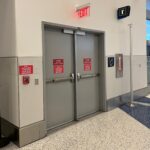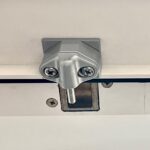
This fire exit door has fire exit hardware, but not all fire exit doors are required to have fire exit hardware. Yes, I’m sure. 🙂
Sometimes I feel like I’ve written about a topic from every possible viewpoint, but then someone asks a question that inspires me to look at the issue from another angle. Today’s Quick Question is:
Do all fire exit doors have fire exit hardware?
Although this might come as a surprise to some of you, the answer is…NO!
The term “fire exit” is not defined in the model codes, so let’s assume that we are talking about a door that is part of a means of egress and would be used by building occupants to exit if there was a fire. In many cases, these are the same doors that would also be used on a regular basis for access and egress. Some have exit signs, some don’t, but they are all part of the means of egress that extends from any point in a building to the public way (there’s more about the means of egress here).
It would seem logical that fire exit hardware belongs on fire exit doors, but what IS fire exit hardware? Here’s how it is defined by the International Building Code (IBC), with some supplemental information from the IBC Commentary:
FIRE EXIT HARDWARE. Panic hardware that is listed for use on fire door assemblies.
Commentary: Where a door that is required to be of fire-resistance-rated construction also has panic hardware, the hardware is required to be listed for use on the fire door. Thus, fire door hardware has been tested to function properly where exposed to the effects of a fire (see the definition for “Panic hardware” and Section 1010.1.10).
So, fire exit hardware is a type of panic hardware that is used on fire doors. Two things to note:
- Not all doors in a means of egress (AKA “fire exit” doors) are fire doors. The purpose of a fire door assembly is to compartmentalize a building and deter the spread of smoke, flames, and toxic gases. In most cases, these doors also function as part of the means of egress, but fire doors would typically be found on stairwells, residential unit entries, and incidental use areas. A fire door assembly might have fire exit hardware, but not always (read on).
- Remember that fire exit hardware is a type of panic hardware, which is listed for both panic and fire. Panic hardware is required for doors serving specific areas – not for all egress doors. For example, the IBC requires panic hardware for doors serving assembly and educational occupancies with an occupant load of 50 people or more, as well as high hazard occupancies. If a door is serving another type of occupancy – even one with a large occupant load – panic hardware is not required by the IBC (although it is acceptable to use even when not required).
Doors that are part of a means of egress are typically required to have hardware that allows building occupants to unlatch the door with one releasing operation, but there are other types of hardware (such as lever handles) that meet this requirement. If the door is serving an occupancy type and occupant load that requires panic hardware, and if the door is a fire door, that’s when the “fire exit” door would require fire exit hardware.
Make sense? Check out these videos for more information about panic hardware and fire doors.
~~~
This post is dedicated to someone who I am very proud of for his attention to doors and hardware while he is also watching the bottom line. 🙂
You need to login or register to bookmark/favorite this content.






There is always confusion when dealing with fire safety. Fire rated exits and fire exits (life safety doors) do differ in the types of hardware required . Occupancy also has an impact on the type of hardware required. Stair well doors and hallway doors that provides a means of exit are often Fire Rated to simply help contain the spread of flames and smoke . Exterior exits doors although along the path of the fire route exit do not need to be Fire Rated. Unless they exit to an adjacent building within 10 feet or 6 meters as in an alley way between buildings. However I often find even the inspectors get this wrong just because they see an exit sign over the door .
“”””The term “fire exit” is not defined in the model codes””””””””
I am working on my code proposal to outlaw the use of any other word, when associated with “exit”
An exit is an exit.
To me the most important point of rated fire exit hardware and panic hardware is that usually the panic hardware does cannot serve where a fire rating is required. I do not know how many buildings I have been in where one only needs to look at the label on a door when in an unfamiliar building and note that if there is an obvious means of dogging the door deranged (not latching) to know you are looking at unrated panic hardware applied to a door that needs rated hardware. Indeed most of the time it says panic hardware on the hardware.
I have talked to many in the construction trades who have never understood the difference between unrated panic hardware and fire rated hardware. Hopefully I am using correct terminology.
As I explain to all contractors and Fire Inspectors… there is a big difference in Fire Rated Hardware. Why do you think they make it… like so many of you I have been to hundreds of sites in my career only to see non rated hardware used especially after they decided to install card access systems . As in non rated electric strikes . Etc.